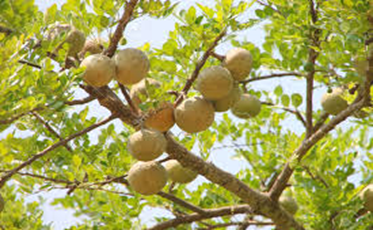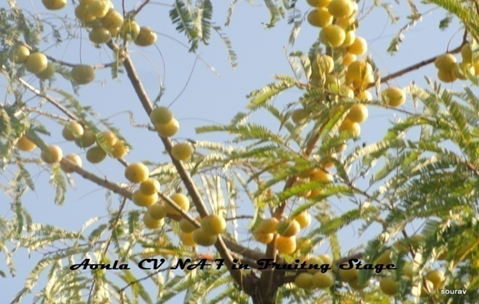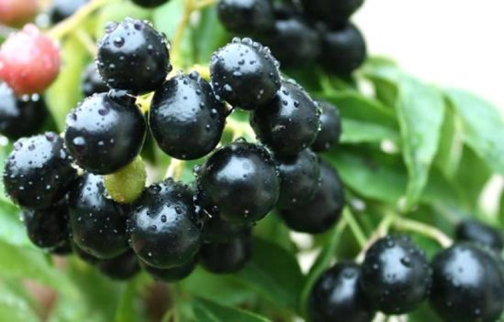Authors: Vijay Kumar1, Rakesh Kumar2, Ajay Kumar3, and Brejesh Ajrabat4,
1,2Rainfed Research Sub-Station for Sub-tropical Fruits, Raya &
3,4Krishi Vigyan Kendra, Kathua
Sher-e-Kashmir University of Agricultural Sciences & Technology of Jammu (J&K) India-180 009
Corresponding E-mail:- vijaykumar.1144@yahoo.com
Bael ( Aegle marmelos corr.) is one of the oldest fruit cultivated in India from prehistoric times. Bael is propagated by seed, patch budding and grafting. The tree is deciduous grows to great height with white-grayish stem. Leaves are trifoliate, branches are spiny bark is shallowly furrowed and corky. Flowers are bisexual borne in clusters sweet scented and greenish white. Fruit is hard shelled berry usually globosely with a pericarp nearly smooth grayish yellow about 3 mm thick, hard and filled with soft yellow and orange, very fragrant and pleasantly flavoured pulp.
The bael fruit is highly nutritious value 100g edible pulp will contain 61.5 g water ,1.8 protein , 0.39 g fat , 1,7 g mineral , 31.8 g carbohydrates, 55 mg carotene , 0.13 mg thiamine , 1.19 mg riboflavin ., 1.1 mg niacin and 8 mg vitamin C.

The fruit is of great medicinal value. The ripe fruit is aromatic, astringent, cooling and laxative. The unripe or half ripe fruit is astringent, stomachic, antiscorbutic and digestive. It is best given in subacute or chronic cases of diarrhoea and dysentery and in irritation of the elementary canal; it is a useful adjunct in after treatment of bacillary dysentery. The ripe fruit is prescribed in intestinal disorders and certain forms of dyspepsia characterized by alternate constipation and diarrhoea. A sherbet of the ripe fruit is given for chronic constipation and dyspepsia.
Aonla (Emblica officinalis) is usually propagated by seeds and vegetative. The plant is sensitive to frost and drought. Flowers usually appear in the hot season and fruits ripen during the following winter. It is sour and stringent and is occasionally eaten raw. It is much esteemed for making pickles, preserves and jellies. the fruit pulp contains moisture 81.2% , protein 0.5% , fat 0.1 % mineral matters 0.75, fibre 4.4%, carbohydrates 14.1% calcium 0.05% and phosphorus 0.02% , iron 1.2mg/100 gm , nicotine acid 0.2 mg /100 gm and vitamin C 600 mg/100g.
Aonla fruit is probably the richest known natural source of vitamin C. the fruit juice contains nearly 20 times as much vitamin C as orange \juice and a single fruit is equal in antiscorbutic value to one or two oranges. A tannin containing gallic acid , ellagic acid and glucose in its molecules and naturally present in the fruit , prevents or retards the oxidation of the vitamin and provides the fruits a valuable antiscorbutic factor in the fresh as well as in the rainfed/dry condition.

The fruit is pungent and cooling .It promotes the discharge of urine and is a laxative .Dried fruit is useful in haemorrhage, diarrhea and dysentery .In combination with iron, it is used as a remedy for anaemia, jaundice and indigestion. Fermented liquor prepared from the fruit is used in jaundice, indigestion and cough.
Triphala consisting of equal parts of powered embica myrobalan chebulic myrobalan (terminalia chebula) and Balearic myrobalan (Terminalia ballerica) is used as a laxative and in a headache, indigestion constipation , piles, enlarged livers and an abnormal accumulation of a fluid in the cavity . The exudation from incisors on the fruits is used as an external application for the eyes. The flowers are cooling refrigent and a laxative or mild cathartic. The seeds contain a fixed oil with a characteristic odour.
Jamun (Eugenia jambulana) is an evergreen tropical and sub-tropical tree. Jamun is a delicious tropical plum-like fruit rich in vitamins and minerals. Fruit is eaten in health snack in many parts of the India. Fruit, seeds, bark and leaves of Jamun have many medicinal properties

It is one of the best medicinal benefits and its anti-diabetic properties. The black plum works against diabetes and convert sugar into energy. The Jamun fruit is excellent for digestive system because of its coolant features. Jamun is being having astringent properties, helps to prevent acne, blemishes, wrinkles and pimples. The black plum has many vital nutrients. The nutrition values and nutritional properties of Jamun are as follows: The Jamun fruit is loaded with sugars like glucose and fructose along with lesser calories. The 100 grams of the fruit contain nutrients: calcium (15 mg), iron (1.41 mg), magnesium (35 mg), phosphorous (15 mg), sodium (26.2 mg), vitamin C (18 mg), thiamine (0.019 mg), riboflavin (0.009 mg), niacin (0.245 mg), vitamin B6 (0.038 mg), calories (62 k cal), carbohydrate (14 gm), carotene (48 ug), folic acid (3 mg), fiber (0.6 gm), fat (0.23 gm), protein (0.995 gm), water (84.75 gm). It is also good for blood due to more amount of iron. The fruits of bael, Jamun and aonla fruits for many more beneficial effects in the human body. It is the rich source of proteins, fats, carbohydrate, sodium, iron and vitamins etc.
About Author / Additional Info:
I am Scientist in SKUAST-J